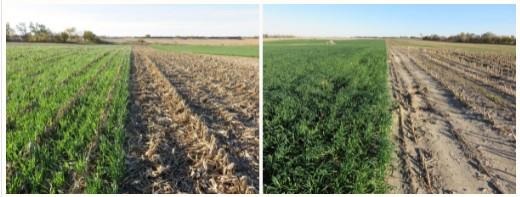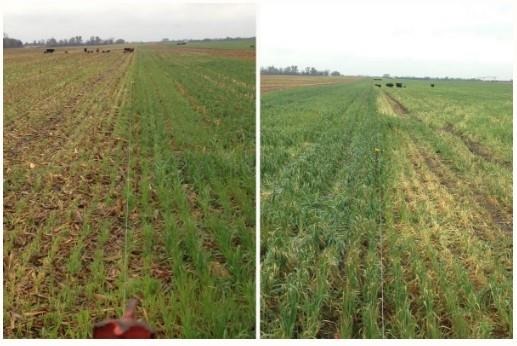By Lindsey Anderson and Humberto Blanco et.al
Separation of crop and livestock production can degrade soil and other natural resources while reducing economic returns. Additionally, the conversion of grassland to cropland has put a strain on forage for cattle. Grazing cover crops can be a potential option to re-integrate crops with livestock production and reverse the adverse effects of separating crops and livestock production. Grazing cover crops could still maintain the benefits from cover crops as roots and some stubble remain after grazing. Cover crop grazing has shown to improve economic returns (Franzluebbers and Stuedemann, 2007) while still capturing benefits from cover crops (Faé et al., 2009; Maughan et al., 2009); however, soil compaction risks can be a concern.
While there are few studies evaluating cover crop grazing, most of the existing studies found any shallow soil compaction that did occur was not enough to influence yields. Tillage and soil wetness could influence the impact of cover crop grazing on soil compaction. A study under strip tillage in west central Nebraska found that grazing cover crops increased soil compaction in one of three years, but it is possible strip tillage may have alleviated potential compaction in the other two years (Blanco-Canqui, et al., 2020).
On the other hand, a study in Georgia found that compaction increased more when grazing under conventional tillage (disk plowing to 6-8 in.) compared to grazing under no-till (Franzluebbers and Stuedemann, 2008). This suggests conservation tillage, such as no till or strip till, could be more beneficial than conventional tillage when grazing cover crops. Another study in Georgia found cover crop grazing in the spring after an above-average rainfall increased soil compaction due to soil wetness and thus reduced cotton yields (Schomberg et al., 2014). Thus, soil wetness is also important to consider when cover crop grazing.
To further improve our understanding of how cover crop grazing may affect soil properties and crop yields, we conducted a study in 2019 and 2020 on a field-scale oat cover crop grazing experiment under an irrigated no-till corn-soybean rotation on silt loam soils in eastern Nebraska. Our results suggest that fall/winter cover crop grazing does not negatively impact soil or crop yields (Figure 1). These results are similar to other fall/winter cover crop grazing studies, but it should also be noted our study only had cover crop following the corn phase of the rotation, thus grazing only occurred every other year, possibly reducing any cumulative impacts of grazing.
Figure 1. Summary table of soil and crop response to cover crop grazing compared to non-grazed cover crop. Penetration resistance and bulk density are soil compaction parameters. Wet and dry aggregate stability are indicators of water and wind erosion. Particulate organic matter is the fraction of organic matter readily accessible for soil microbes to use.| Parameters | Impact of cover crop grazing compared to non-grazed cover crop |
|---|
| Soil Properties | |
| Penetration Resistance | no effect |
| Bulk Density | no effect |
| Wet Aggregate Stability | no effect |
| Dry Aggregate Stability | no effect |
| Cumulative Infiltration | no effect |
| Water Retention | no effect |
| Organic Matter | no effect |
| Particulate Organic Matter | no effect |
| Microbial Biomass | no effect |
| | |
| Crop Yields | |
| Soybean | no effect |
| Corn Silage | no effect |
| High Moisture Corn | no effect |
Field Management

Figure 2. Oat cover crop biomass in October compared to the no cover crop control for high moisture corn (left) and corn silage (right). (Photos by Mary Drewnoski)
Our cover crop grazing experiment was established in 2015 at the Eastern Nebraska Research and Education Center near Mead, Nebraska. There were two study fields in this experiment, and each field was 52 acres under center pivot irrigation and no-till. The rotation was corn-soybean, and each field was cut in half and harvested as corn silage in one-half of the field and high moisture corn in the other half of the field. Corn silage was harvested around Sept. 1 and high moisture corn (about 32% moisture) harvested around Sept. 15, about 25 days before typical dry corn (about 15% moisture) harvest. A cover crop of Horsepower oat was drilled at 96 lbs per acre following corn harvest (Figure 2). Following cover crop planting, the fields received 40 lbs N per acre from ammonium nitrate. No cover crop was planted following soybean harvest.
Cattle Management
Cattle grazed from November to December at stocking rates ranging from 0.6 to 1.7 head per acre, with cattle initial weights ranging from 507 to 553 pounds throughout the study. The stocking rates were calculated based on a target grazing period of 70 days and accounted for cover crop biomass under corn silage and both cover crop biomass plus corn residue amount under high moisture corn. Forage allowance was about 25.6 pounds per steer per day in the first two years and about 39.0 pounds per steer per day in the last three years. Grazing only occurred in late fall/winter following the corn phase of the rotation with grazing durations ranged from 30 to 69 days over the five-year experiment. Based on the rotation, grazing occurred twice in one field and three times in the other field over a five-year period.
Did Cover Crop Grazing Damage Soils?
Cover crop grazing had no impact on soil compaction, wind or water erosion potential (expressed as wet and dry aggregate stability), water infiltration, water retention, organic matter, particulate organic matter (fraction of organic matter readily accessible to soil microbes), or microbial biomass compared to the non-grazed cover crop (Figure 1). These findings strongly suggest that cover crop grazing does not damage soils.
Why Might Grazing Not Impact Soils?
It is believed cover crop grazing had no impact on soil compaction in this experiment because:
- Grazing only occurred after the corn phase of the corn-soybean rotation, which reduced the frequency of grazing (every other year grazing).
- The experiment was located on soil with high soil organic matter (4.2% within 0 to 8 inches) and soil organic matter can prevent soil compaction.
- Grazing occurred in late fall when the soil is less likely to be wet compared to spring, with spring having more rainfall.
- Natural freeze-thaw and wetting-drying soil cycles can naturally break up any potential soil compaction.
Cover crop grazing removed about 47 to 87% of cover crop biomass due to cattle intake and trampling (Figure 3). However, much of the biomass removed was actually incorporated into the soil surface from trampling, retaining cover crop residue within the system. Additionally, cattle intake removes little nutrients from the system, as cattle excrete most of the nutrients consumed during grazing. For these reasons above, we believe cover crop grazing in this study may have had no negative impact on soil properties due to the addition of trampled cover crop aboveground biomass, cover crop root biomass and infrequency of grazing (every other year).
Did Cover Crop Grazing Impact Crop Yields?
Cover crop grazing had no impact on soybean or corn yields (Figure 1), which is similar to previous cover crop grazing experiments. Only two studies report yield decreases from cover crop grazing during wet soil conditions in spring (Schomberg et al. 2014) or increased soil water evaporation from summer cover crop grazing reducing residue cover (Franzluebbers and Stuedemann, 2007). Our study site was irrigated and grazed in fall/winter.
Should I Graze My Cover Crops?

Figure 3. Cattle grazing oat cover crop and corn residue in November following high moisture corn (left) and grazing cover crop following corn silage (right). Grazing reduced cover crop biomass by 47 to 87% under corn silage. Grazing reduced cover crop biomass by 64 to 87% and reduced corn residue by 18 to 23% under high moisture corn. (Photos by McKenna Brinton)
- In this study, cover crop grazing had no impact on soil compaction, wind or water erosion potential, water infiltration, water retention, organic matter, particulate organic matter or microbial biomass compared to the non-grazed cover crop. Therefore, based on the conditions of this study, fall/winter cover crop grazing had no negative impacts on soil properties. Additionally, cover crop grazing had no impact on crop yields.
- In previous studies, cover crop grazing can have some impact on soil compaction, depending on tillage system and soil conditions at time of grazing. Based on what little research is available, it is suggested conservation tillage — such as no till or strip till — may prevent possible accumulated impacts of compaction, but conventional tillage should be avoided.
- Based on our experiment and others, cover crop grazing could be a strategy to re-integrate crop and livestock production without largely degrading soil properties or impacting crop yields.
Acknowledgements
We thank Nebraska Environmental Trust and the USDA SARE for their funding of this research. Also, we thank Kallie Calus, McKenna Brinton, Benjamin Hansen, Kristen Ulmer, Zachary Carlson and Fred Hilscher for their work on this research. Additionally, we thank Mark Schroeder and team at the Eastern Nebraska Research and Education Center for field management, Husker Genetics for acquiring and planting oats, Elizabeth Jeske for soil microbial analysis, and all undergraduate and graduate students assisting with fieldwork.
Source : unl.edu